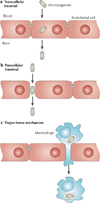Mechanisms of microbial traversal of the blood-brain barrier
- PMID: 18604221
- PMCID: PMC5206914
- DOI: 10.1038/nrmicro1952
Mechanisms of microbial traversal of the blood-brain barrier
Abstract
Central nervous system (CNS) infections continue to be an important cause of morbidity and mortality. Microbial invasion and traversal of the blood-brain barrier is a prerequisite for CNS infections. Pathogens can cross the blood-brain barrier transcellularly, paracellularly and/or in infected phagocytes (the so-called Trojan-horse mechanism). Consequently, pathogens can cause blood-brain barrier dysfunction, including increased permeability, pleocytosis and encephalopathy. A more complete understanding of the microbial-host interactions that are involved in microbial traversal of the blood-brain barrier and the associated barrier dysfunction should help to develop new strategies to prevent CNS infections.
Figures




References
-
- World Health Organization. Geneva: WHO; 2004. World health report: changing history.
-
- Klinger G, Chin C-N, Beyene J, Perlman M. Predicting the outcome of neonatal bacterial meningitis. Pediatrics. 2000;106:477–482. - PubMed
-
- Chang C-J, et al. Bacterial meningitis in infants: the epidemiology, clinical features, and prognostic factors. Brain Dev. 2004;26:168–175. - PubMed
-
- van de Beek D, et al. Clinical features and prognostic factors in adults with bacterial meningitis. N. Engl. J. Med. 2004;351:1849–1859. - PubMed
Publication types
MeSH terms
Grants and funding
LinkOut - more resources
Full Text Sources
Other Literature Sources

